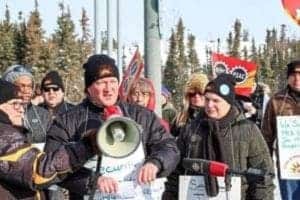The Union of Northern Workers (UNW) bargaining on behalf of almost 4,000 territorial government employees, says its membership voted 70 per cent in favour of a strike mandate.
“I am very pleased with the outcome of this vote,” said Todd Parsons, president of the Union of Northern Workers (UNW). “Our members have articulated that they are not interested in the current offer.”
Voting members rejected the employer's offer of a zero per cent wage increase for the first two years, a one per cent increase in the third year and a 1.1 per cent increase in the fourth year.
The union will exhaust all of its options under the Public Service Act to come to an agreement and avoid a work stoppage, said Parsons in a news release.
The union is pushing for a three per cent yearly wage increase for the period of 2016 to 2018, Northern allowance improvements, reduced casual and precarious employment, full-time indeterminate work and mental health supports for public service employees.
The GNWT's department of finance could not be reached for comment as of press time to clarify its stance on the strike mandate.
GNWT workers and the government have not had a contract since the previous one expired March 31, 2016.
In 2015 there was a wage increase of 3.3 per cent. Since then there have been zero salary increases.
The UNW is also pushing for a three, rather than four year collective agreement, said Parsons.
“Our purpose is not to strike, because a strike is bad for everyone. It is a powerful tool that we have been given and I hope that we don't have to use it,” said Parsons.
In a document outlining potential job action, the GNWT states there is no reliable way to predict the duration of a strike.
n light of the mandate, the GNWT has outlined its contingency plans for a work stoppage – maintaining operation of its essential services including operation of courts, protecting health and public safety and to prevent destruction of machinery or premises.
“Negotiations have not gone well over the last two years,” he said, adding that he hopes the strike mandate will encourage the GNWT to “do what's right.”
The ultimate responsibility to sign a collective agreement on behalf of the GNWT rests on cabinet, which sets the bargaining direction for the government's negotiating team.
This is the first time in the 50 year existence of the bargaining unit there has been a strike mandate during negotiations with the territorial government.
The scheme for wage increases for territorial MLAs – among the highest paid public servants in Canada – should also be extended to other public service employees, said Parsons.
Member's wages pace with the Consumer Price Index, but amid the closure of a diamond mine and budget austerity, MLAs agreed to take a two-year pay freeze which expired as of April 1, 2018.
Regular members earn a base salary of $103,851 and receive pay bumps for additional duties. The premier receives an additional $78,986 while cabinet ministers take home an additional $55,583. MLA wages won't be subject to any ongoing freezes.
In 2015, government represented 16.4 per cent of the territorial GDP, behind the NWT's largest economic generator, natural resources, which generated 24.4 per cent of the GDP in 2015.
No salary increases means GNWT employees lose a percentage of their purchasing power for every year that wages stagnate, said Parsons.
The GNWT ran a $175-million surplus, but did not invest any of that money into salary raises.
“100 per cent of your surpluses should not be invested in infrastructure,” said Parsons. “A percentage should be invested in your workers.”
The union is seeking a multitude of labour standard improvements that discourage the use of “precarious” work.
Around 25 per cent of the government's labour force runs on precarious employment which includes positions on contract, casual or on-call designations.
“I would hope that the strength this provides the bargaining team that the employer will listen and hopefully return to the bargaining table with a fair offer and an opportunity to reach a tentative agreement,” said Parsons.
